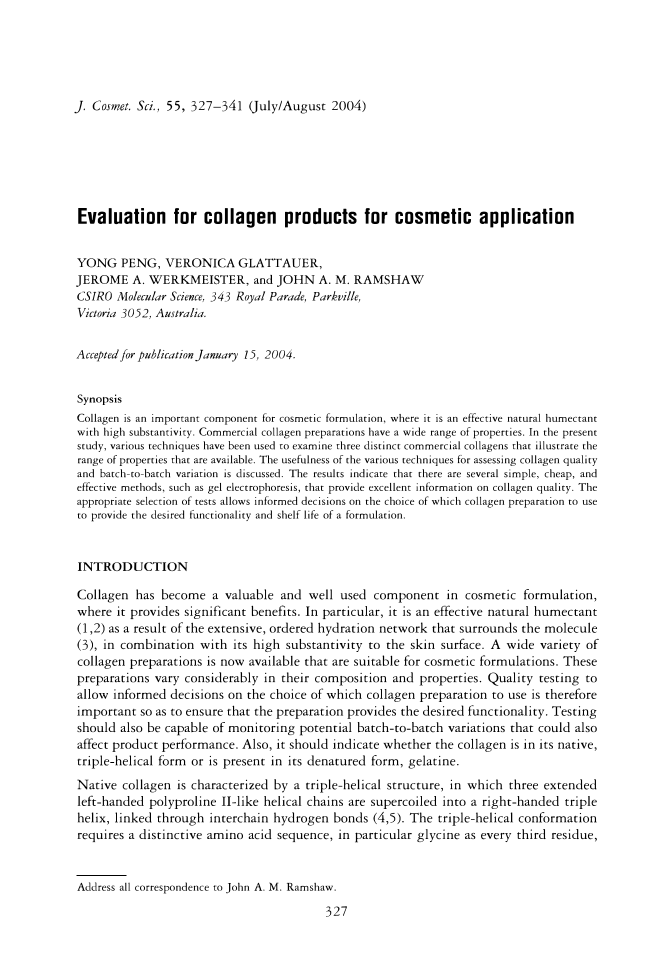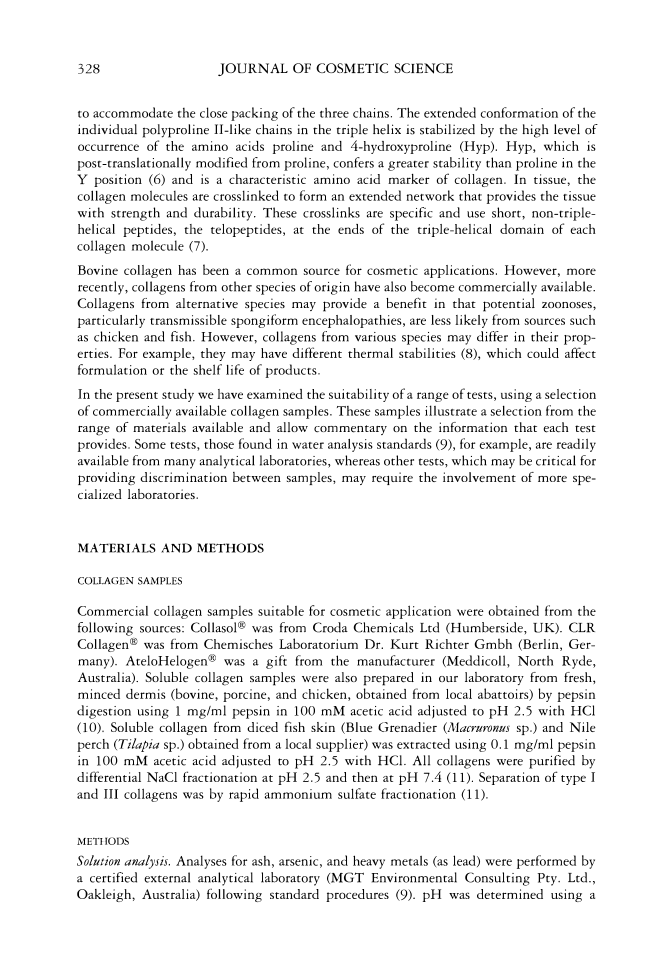J. Cosmet. Sci.J 55, 327-341 Quly/August 2004) Evaluation for collagen products for cosmetic application YONG PENG, VERONICA GLATTAUER, JEROME A. WERKMEISTER, and JOHN A. M. RAMSHA W CSIR0 Molecular Science} 343 Royal Parade, Parkville, Victoria 3052, Australia. Accepted for publication January 15, 2004. Synopsis Collagen is an important component for cosmetic formulation, where it is an effective natural humectant with high substantivity. Commercial collagen preparations have a wide range of properties. In the present study, various techniques have been used to examine three distinct commercial collagens that illustrate the range of properties that are available. The usefulness of the various techniques for assessing collagen quality and batch-to-batch variation is discussed. The results indicate that there are several simple, cheap, and effective methods, such as gel electrophoresis, that provide excellent information on collagen quality. The appropriate selection of tests allows informed decisions on the choice of which collagen preparation to use to provide the desired functionality and shelf life of a formulation. INTRODUCTION Collagen has become a valuable and well used component in cosmetic formulation, where it provides significant benefits. In particular, it is an effective natural humectant (1,2) as a result of the extensive, ordered hydration network that surrounds the molecule (3), in combination with its high substantivity to the skin surface. A wide variety of collagen preparations is now available that are suitable for cosmetic formulations. These preparations vary considerably in their composition and properties. Quality testing to allow informed decisions on the choice of which collagen preparation to use is therefore important so as to ensure that the preparation provides the desired functionality. Testing should also be capable of monitoring potential batch-to-batch variations that could also affect product performance. Also, it should indicate whether the collagen is in its native, triple-helical form or is present in its denatured form, gelatine. Native collagen is characterized by a triple-helical structure, in which three extended left-handed polyproline II-like helical chains are supercoiled into a right-handed triple helix, linked through interchain hydrogen bonds (4,5). The triple-helical conformation requires a distinctive amino acid sequence, in particular glycine as every third residue, Address all correspondence to John A. M. Ramshaw. 327
328 JOURNAL OF COSMETIC SCIENCE to accommodate the close packing of the three chains. The extended conformation of the individual polyproline II-like chains in the triple helix is stabilized by the high level of occurrence of the amino acids praline and 4-hydroxyproline (Hyp). Hyp, which is post-translationally modified from praline, confers a greater stability than praline in the Y position (6) and is a characteristic amino acid marker of collagen. In tissue, the collagen molecules are crosslinked to form an extended network that provides the tissue with strength and durability. These crosslinks are specific and use short, non-triple helical peptides, the telopeptides, at the ends of the triple-helical domain of each collagen molecule (7). Bovine collagen has been a common source for cosmetic applications. However, more recently, collagens from other species of origin have also become commercially available. Collagens from alternative species may provide a benefit in that potential zoonoses, particularly transmissible spongiform encephalopathies, are less likely from sources such as chicken and fish. However, collagens from various species may differ in their prop erties. For example, they may have different thermal stabilities (8), which could affect formulation or the shelf life of products. In the present study we have examined the suitability of a range of tests, using a selection of commercially available collagen samples. These samples illustrate a selection from the range of materials available and allow commentary on the information that each test provides. Some tests, those found in water analysis standards (9), for example, are readily available from many analytical laboratories, whereas other tests, which may be critical for providing discrimination between samples, may require the involvement of more spe cialized laboratories. MATERIALS AND METHODS COLLAGEN SAMPLES Commercial collagen samples suitable for cosmetic application were obtained from the following sources: Collasol® was from Croda Chemicals Ltd (Humberside, UK). CLR Collagen® was from Chemisches Laboratorium Dr. Kurt Richter Gmbh (Berlin, Ger many). AteloHelogen® was a gift from the manufacturer (Meddicoll, North Ryde, Australia). Soluble collagen samples were also prepared in our laboratory from fresh, minced dermis (bovine, porcine, and chicken, obtained from local abattoirs) by pepsin digestion using 1 mg/ml pepsin in 100 mM acetic acid adjusted to pH 2.5 with HCl (10). Soluble collagen from diced fish skin (Blue Grenadier (Macruronus sp.) and Nile perch (Tilapia sp.) obtained from a local supplier) was extracted using 0.1 mg/ml pepsin in 100 mM acetic acid adjusted to pH 2.5 with HCl. All collagens were purified by differential NaCl fractionation at pH 2.5 and then at pH 7.4 (11). Separation of type I and III collagens was by rapid ammonium sulfate fractionation (11). METHODS Solution analysis. Analyses for ash, arsenic, and heavy metals (as lead) were performed by a certified external analytical laboratory (MGT Environmental Consulting Pty. Ltd., Oakleigh, Australia) following standard procedures (9). pH was determined using a
Purchased for the exclusive use of nofirst nolast (unknown) From: SCC Media Library & Resource Center (library.scconline.org)






































































































